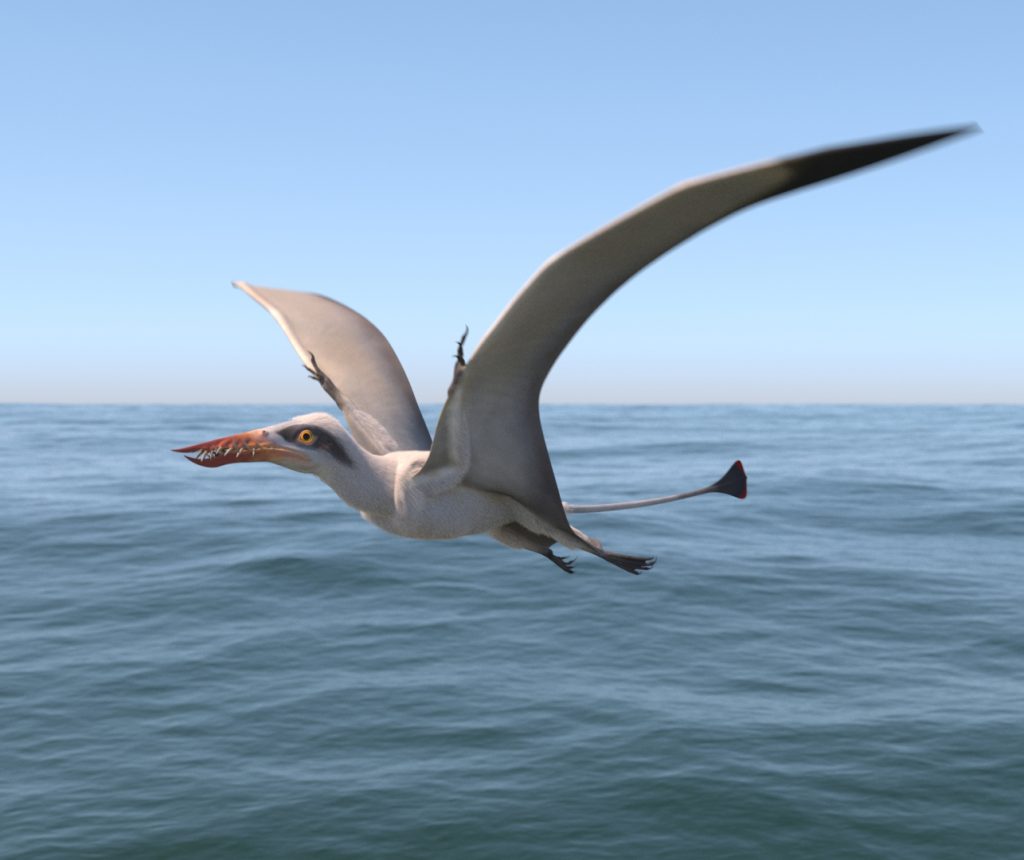The Rhamphorhynchus was a small flying reptile that lived along the shorelines during the Triassic, Jurassic, and Cretaceous periods. This prehistoric flying reptile was an excellent flier and swimmer with wide flat feet and an impressive wing span. They might have been small, but these aggressive flying reptiles flew in the skies for almost 200 million years!
Table of Contents
Some Quick Facts about the Rhamphorhynchus

| Name | Rhamphorhynchus (meaning “beak snout”) |
| Type of dinosaur | Pterosauria |
| Territory | Shorelines and lakes, England, Tanzania, Germany, Bavaria, Portugal |
| Size | 4 feet long, |
| Color | Unknown |
| Interesting Characteristics | Large wingspan, the tip of its tail was diamond-shaped |
| Diet | Insects and fish |
| Major Threats | Larger dinos, natural disasters |
The Rhamphorhynchus was a small, Pterodactyl-like flying reptile with a snout full of needle-sharp teeth for chomping on tasty fish. And unlike other Pterosaurs, the Rhamphorhynchus lived in the Triassic, Jurassic, and Cretaceous ages.
What Is the Meaning of Rhamphorhynchus?
There are a lot of letters in the name Rhamphorhynchus, so let’s break it into syllables.
Rhamphorhynchus is pronounced Ram-foe-rink-us. We can break down the name into two parts, ‘rhamphos’, and ‘rhynchus’.
Rhamphos is an Ancient Greek term for ‘beak’, and ‘rhynchus’ means snout. When you bring them together, you get ‘beak-snout,’ which describes the Rhamphorhynchus’ nose. Aside from its tail, the long snout of this bird was its most fascinating feature and the reason it earned its name, beak-snout!
What Did a Rhamphorhynchus Look Like?
From far away, the Rhamphorhynchus may have looked like a giant, majestic heron. It had a very long snout, large wingspan, and similar size. However, as you get closer to this prehistoric pterosaur, it looks nothing like a heron!
While this prehistoric creature could fly through the air like a bird, it wasn’t a bird but a flying reptile. It had a very long tail vane of soft tissue with a diamond-shaped tip, similar to a Dimorphodon or a Pterodactylus.
These long-tailed Pterosaurs only weighed 1-2 pounds, which is about the same as a swan. And when standing on land, they were around 4 feet long. However, when they took to flight, they had a massive wingspan of almost 6 feet!
As far as its skin is concerned, the Rhamphorhynchus leaves paleontologists scratching their heads. While it took flight like a bird, it also had a lot of reptilian features. Some paleontologists believe that it did not have feathers but the skin of a reptile. However, recent research indicates that some Pterosaurs, like the Rhamphorhynchus, may have had brightly colored feathers.
What Did a Rhamphorhynchus Eat?
As a water-dwelling pterosaur, it is no surprise that the Rhamphorhynchus ate fish. It had small, needle-like teeth that were angled forward. The angle of these teeth allowed it to dive into the water and snatch up a fish with its very sharp teeth. These flying reptiles also dined on other things along the shoreline, such as prehistoric insects.
While its habitat told a part of the tale of what this dino liked to eat, the fossil records tell the other half. By looking at the fossil remains, paleontologists discovered that their stomachs contained sea-faring creatures like octopus, nautilus, cuttlefish, and squid.
Could the Rhamphorhynchus Fly?

Not only could the Rhamphorhynchus, but it was one of the best flying reptiles of the dino age. It used its strong wings to fly over bodies of water, looking for a snack and escaping predators. They are noted as being some of the first flying vertebrates discovered on planet Earth.
While its body was small and straightforward, its wingspan was a sight to behold. Its wing membrane stretched over a fourth finger and extended back to its hind legs. Young hatchlings couldn’t fly in their early stages, but their fast metabolisms allowed them to grow up quickly to take flight and care of themselves.
In addition to flying, paleontologists believe that the Rhamphorhynchus was excellent at swimming (but not as good as a Tylosaurus). It could dive into the water with its broad, flat feet and swim for a fish.
Was the Rhamphorhynchus a Dinosaur?
No, the Rhamphorhynchus was not a dinosaur but a pterosaur. A Pterosaur is a type of flying reptile that doesn’t belong to the classification of dinos.
Pterosaurs live in a category all their own. They aren’t a bird or a dinosaur because slight differences in their anatomy set them apart. Think of Pterosaurs like the Rhamphorhynchus as a cousin to dinosaurs and birds. They are closely related but don’t belong to the same species.
What Makes the Rhamphorhynchus Special?
The Rhamphorhynchus is one of the few prehistoric creatures to thrive during all three periods of the dino age, the Triassic, Jurassic, and Cretaceous periods. During the Triassic era, dinosaurs and reptiles were small, like the Rhamphorhynchus.
As time passed, Pterosaurs grew massive, and many smaller creatures died. But not the Rhamphorhynchus! The small yet mighty Rhamphorhynchus shared airspace with colossal Pterosaurs like the Quetzalcoatlus that weighed almost 500 pounds and had a wingspan of 33 feet!

